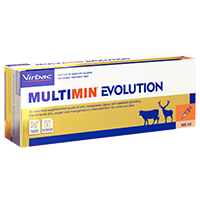
Trace element supplementation for Dairy Cattle
Boost Dairy Herd Health and Performance with MULTIMIN® and MULTIMIN Evolution®.
Most dairy farmers diligently manage their herds' trace element programs, and these generally suffice for much of the year. However, during periods of high demand, such as calving and mating, even well-supplemented herds can experience temporary, trace element deficiencies. These crucial periods can impact overall herd health and productivity.
What is MULTIMIN®
MULTIMIN® is an advanced, injectable trace element supplement containing zinc, copper, selenium and manganese. It's specifically formulated to rapidly and safely boost levels of these vital trace elements in both cattle and deer. For optimal results, MULTIMIN® is best administered before high-demand periods including transition/ pre-calving and pre-mating.
What is MULTIMIN Evolution®?
MULTIMIN Evolution® contains the highest trace mineral content of any trace mineral product in New Zealand in a low volume formulation. With 50% more zinc than MULTIMIN®, MULTMIN Evolution® has been formulated to meet the international recommendations of international nutritional experts for zinc in high producing dairy cows while additionally supporting immune response and reproductive performance.
Why use injectable trace elements?
At key times when animals can dip into deficiency, MULTIMIN® and MULTIMIN Evolution® have been shown to increase blood levels within 2 hours and level levels within 24 hours, ensuring trace elements are available for these periods of increased demand, which often coincide with reduced dietary intake.
Beyond growth: The broader impact of trace elements
Traditionally, trace element supplementation focused primarily on improving growth rates and milk production. However, our understanding has evolved significantly. We now know that trace elements play critical roles across multiple body systems, impacting reproductive performance, including fertility and immunity even more profoundly than previously thought. options, so the decision on which to use comes down to where you most want to make a difference. Crucially, local New Zealand research backs the efficacy of MULTIMIN® and MULTIMIN Evolution® providing concrete data on it's positive effects on dairy herd health and reproductive performance on NZ farms.
MULTIMIN® and disease reduction in adult dairy cows
Calving is a period of significant stress for dairy cows, often leading to a compromised immune system and a peak in disease incidence. A recent study investigating the effect of MULTIMIN® administered 2-4 weeks pre-calving demonstrated remarkable results:
- Halving of clinical mastitis: A similar positive response on that observed in calves.
- 25% reduction in subclinical mastitis: (In cows with over 150,000 somatic cell count at first herd test)
Enhancing dairy cow reproductive performance with MULTIMIN®
Many products claim to improve cow in-calf rates. What sets MULTIMIN® apart is the robust science behind its four trace elements, further strengthened by local New Zealand research.
An original study showed that using MULTIMIN® in already well-performing herds with normal trace element levels resulted in nearly 3% reduction in empty rates. This finding has been consistently replicated across thousands of cows in various regions, with the most recent data showing a 2% increase in 6-week in-calf rates.
When it comes to improving in-calf rates, relying on evidence-based solutions and trusted information sources, in consultation with your veterinarian, is paramount.
Pre-Calving vs. Pre-mating: Which is right for you?
New Zealand studies have shown significant benefits for administering MULTIMIN® or MULTIMIN Evolution® at both pre-calving and pre-mating.
Pre-calving injection: The reduction in mastitis alone yielded an impressive estimated return of $4.00 for every dollar spent.
Pre-mating injection: The financial returns are even stronger, with an estimated return of over 5:1. While the pre-mating injection appears to offer a better direct financial case, the pre-calving benefits include valuable intangible advantages like reduced antibiotic use and less time spent managing sick animals.
Ultimately, the decision to whether to use MULTIMIN® products pre-calving or pre-mating depends on where you most want to see an improvement in your herd's performance. Other periods of high stress where MULTIMIN® supplementation may be beneficial include, when improved immune response is needed (e.g. at vaccination, at dry-ff, during heat stress or prior to transporting). Speak to your vet about your herd's individual requirements.
Is MULTIMIN® or MULTIMIN Evolution® only for problematic herds?
Interestingly, our research indicates the opposite. The best outcomes with MULTIMIN® are observed in well-managed herds that already have low disease levels and good mating results, even with normal trace element levels. Herds facing significant problems are likely to benefit more from a focus on consultancy and changes in management practices. Based on local research, MULTIMIN® is ideally suited for farms that are already performing well and are seeking further, incremental improvements in their herd's health and productivity.
How to use MULTIMIN®
MULTIMIN® should be administered by subcutaneous injection only, following the dosage recommendations below. There are no milk or meat withholding periods when used as directed.
- Cattle (1-2 years): 1 ml/75kg
- Cattle (over 2 years): 1 ml/100kg
To learn more about MULTIMIN® or MULTIMIN Evolution® and how it can benefit your dairy herd, visit performanceready.co.nz or consult your vet.


